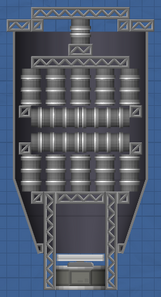
This reaction less engine works as the docking ports on top continuously tug on the docking ports below, dragging the rocket up.
Reactionless engines refer to "engines" that exploit a bug to achieve propulsion without using any fuel. This page contains information on such engines (or more suitably "drives") and how to make one.
Making a reactionless engine is no easy task. The following is known on reactionless engines:
- Only the target rocket is given extra force that is not accounted for by other rocket. This means this simply won't work remotely. You have to be in active control of the rocket you want to move.
- Force is applied in a 6-block (including the center) range. This means you have 5 blocks to work with, and anything past this point does nothing. The more you can figure out the pack into this space, the stronger the drive will be. This is also why stacking drives should be farther than this distance.
- It is slightly off center, favoring the front of the port. This means drives that point ports towards each other will be stronger than those who point away.
- Force has falloff; it is greater the closer the objects are. Try getting your two (or more) parts of the drive as close as possible.
- Framerate dependent: force is applied once every x frames, unlike rockets which occur every frame. Higher framerate means better engine performance. All drives work at any framerate. But if you have a low frame rate, it may not be able to lift off from even the moon.
- Docking ports that have the top side attached to any object will stop working when you reload the game. This may occur when switching rocket as well.
- Docking ports will stop producing all force for 5 seconds after being detached. This may result in noticeable changes in lift and acceleration, both to your benefit and against it.
Some final notes:
- Drives work infinitely. No fuel.
- As of 1.5 it is still possible to create a drive that lifts itself, but can even lift a substantial amount of mass, as shown here
- Drive power is measured in Earth Lifting Capacity. This is very similar to acceleration but done in an easier way to understand and measure by the layman.
- To get the ELC, simply weigh down your drive until it can no longer lift off. Then slowly remove mass until it takes flight.
- A drive needs to be able to sustain flight until it leaves Earth's atmosphere to be considered functional.
- When testing a drive for ELC, the launch should be straight up. Some drives may suffer ELC efficiency loss that would not be apparent during a gravity turn. An example of this can be found in the drive pictured on the right. Its lifting capacity will noticeably decrease 5 seconds after launch due to the toggle mechanism on the top interacting with the drive.
- Currently, it is easier than ever to make a drive due to the ability to edit the magnet force of the docking ports. However, take note that heat may be a problem in making fast rockets.